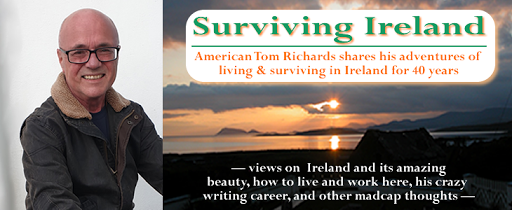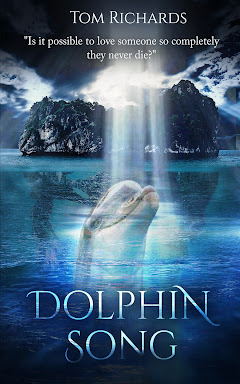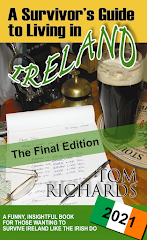 |
| Take the Ferry to Garinish Island for a moment of sensory tranquility |
Visitor: "This is such a great place. The views are stunning!"
Me: "How long are you going to be here?"
Visitor: "Three days. Then we're off to Killarney."
Me: "And what do you plan to do while you're visiting Eyeries and the Beara Peninsula?"
Visitor (sheepishly): "Well that's just the thing. We aren't quite sure. In fact I was hoping you might point out a few things. Can you tell us what we should do?"
Now it could be that if you're reading this Post, you might well be planning a trip to Ireland. However, you could be among the vast majority who have never heard of Beara Peninsula. Beara, after all, is truly one of Ireland's hidden gems. Located in the southwest of the country, about a 2 hour drive from Cork City, and one of the most westerly points of Ireland, the region has remained something of a secret. Even Irish friends of mine living in Dublin have never heard of it.
But I'll tell you something: if you're planning a trip to Ireland without Beara as part of your itinerary, you're going to be missing something huge! Yes, you can go to Dingle and the Ring of Kerry and Bunratty Folk Park and all the other 'top-of-mind' places, joining thousands of mad tourists who must also visit these fine locations.
Or you could come to Beara and get a glimpse of magic.
But back to the question: "Tom, where should I go when visiting Beara Peninsula?" the fella may ask. I've repeated my list of favorite destinations over and over again. So in self-defense I thought I'd write down a list. That way if I'm ever asked again I'll just say: "Read the Blog, okay?" And that will be that.
Now it could be that if you're reading this Post, you might well be planning a trip to Ireland. However, you could be among the vast majority who have never heard of Beara Peninsula. Beara, after all, is truly one of Ireland's hidden gems. Located in the southwest of the country, about a 2 hour drive from Cork City, and one of the most westerly points of Ireland, the region has remained something of a secret. Even Irish friends of mine living in Dublin have never heard of it.
But I'll tell you something: if you're planning a trip to Ireland without Beara as part of your itinerary, you're going to be missing something huge! Yes, you can go to Dingle and the Ring of Kerry and Bunratty Folk Park and all the other 'top-of-mind' places, joining thousands of mad tourists who must also visit these fine locations.
Or you could come to Beara and get a glimpse of magic.
But back to the question: "Tom, where should I go when visiting Beara Peninsula?" the fella may ask. I've repeated my list of favorite destinations over and over again. So in self-defense I thought I'd write down a list. That way if I'm ever asked again I'll just say: "Read the Blog, okay?" And that will be that.
Tom's Favorite Things to Do on Beara Peninsula
To answer the question I'm going to make some assumptions. Let's say you are planning to come to Beara Peninsula. You are part of a family of four: two adults with two children aged 12 and 15. You want to spend some time relaxing, of course, but also exploring and experiencing this out-of-the-way gem of an Irish location.
I'm also going to make the assumption you've traveled to Ireland from the States and landed in Dublin. You've rented a car - so have your own wheels - and have made your way to the Southwest of Ireland.
Now what? you might ask. And here are the answers.
First Stop:
Bantry, County Cork - Bantry is the gateway to Beara, and the largest town on the Peninsula. They've a great Market in the Square every Friday offering anything from Veg to bric-a-brac, local artwork, and stalls with fine eating. Pick up a few trinkets for the friends at home. Then take a stroll along the Main street and its many shops, perhaps treat yourself to a fishy feed at the Fish Kitchen (one of my favorites - try their seafood chowder), then take an after-dinner walk along the Harbour.
Bantry is located at the very eastern end of Bantry Bay (naturally) and all sorts of vessels are tied up including the large blue Tugboat used to push incoming supertankers visiting Whiddy Island with loads of oil and petroleum products. To my knowledge Whiddy is the only such oil terminal in the Republic of Ireland.
But Bantry is only the entry-way to Beara. Now the fun truly begins.
Glengarriff - from Bantry drive west down the coast and get ready for stunning scenery. The Caha and Mishkish Mountains form a spine of craggy rocks all the way down the Peninsula and your roving eyes will be split between their stunning vistas and the view across Bantry Bay. Drive into Glengarriff and be prepared to spend a few hours - or a few days.
Actress Maureen O'Hara called the village home for many years and it's no wonder. I've spent lovely days walking along its single main street, stopping at local woolen shops to see what's on offer, and idling along the craggy coastline. Your family will all enjoy the Bamboo Park filled with over 30 different species of Bamboo (which, I gather, is why they call it a Bamboo Park), or ramble through nearby Glengarriff Woods Nature Reserve and its mature Oaks, streams and rivers.
Make sure you save some time to visit Garinish Island. It costs a couple of quid to take the Blue Pool Ferry across but it's more than worth it. Before arriving keep your eyes open for seals basking on the rocks. Then walk through one of Ireland' unique locations. Garinish is filled with a wide variety of tropical plants, and as their website says, "it is an island of rare beauty known to horticulturists and lovers of trees and shrubs all over the world."
The Gulf Stream, located just off Beara's coast, helps to create the micro-climate which makes such stunning vegetation possible.
Castletownbere - or Castletown Berehaven, as it's officially known. But that's too much for the locals who usually call it simply 'Town'.
Leaving Glengarriff, continue due west along the stunning coast. If you've a mind for a nice meal along the way I heartily recommend the Berehaven Lodge Restaurant, and not because they've paid me for the plug. They haven't. Located 5 km before hitting Town, the She in my life and I have eaten there any number of times. A few weeks ago we treated ourselves to a simply wonderful Sunday dinner. I had a Sirloin Steak with all the Trimmings. She had baked Haddock. We did not have a starter, but She had 2 glasses of wine (as the designated driver I abstained). The bill for all was just over €30 - stupendous value for such good eating. We're told the restaurant offers an outdoor BBQ on Sunday evenings during the Summer. We'll try that next.
Castletownbere is one of Ireland's most important white-fish fishing ports. It was also of strategic value to the British when they still called Ireland part of the Empire. During WWI, the Brits hid their entire Atlantic Fleet right near Town to keep them safe from prowling German U-boats. In fact I was told a fellow could hop from one ship to another, all the way to the other side of Bantry Bay, such was the crammed nature of the Fleet during those days.
Castletown is very much a working town, so don't expect a 'picturesque' spot of Ireland when visiting. Here, take a walk along the solid main street. Stop for a pint in McCarthy's Pub (made famous by writer Pete McCarthy's written pub-crawl, McCarthy's Bar). Have a word with owner Adrianne McCarthy and she just might tell you the story of her late father, Doctor McCarthy, who survived WWII courtesy of Japanese POW camps and lived to tell the tale. And an amazing tale it is, too, with 2 films already shot about his survival and a feature film now in the works.You can read his adventures for yourself in his memoir, A Doctor's War.
Don't leave Town without a walk along the Pier. When the fishing fleet is in, the place is a hive of activity as crews off-load tonnes of catch - everything from deep water local Prawns to mackerel, John Dory, Sole, Monk, and many others. And if you're looking for a cup of tea with a meal of Fish n Chips (using afore-mentioned freshly caught fish) I highly recommend Lynch's on the Pier. Tell owner Darren you know Tom and you just might be thrown out for your efforts.
Or how about a diversion well off the beaten track? If so, I recommend taking your rental car aboard the ferry and onward to Bere Island. Located only a few kilometers by sea from Town, Bere Island is rich in archaeology. While you're there, climb up to the Martello tower. These signal towers where built by the Brits up and down Ireland's east coast to give warning against various European invaders. Should an enemy ship be spotted, a signal would be lit in one of the Towers. Because they were in line-of-sight of each other, a fire in one tower would set off fires in all the other towers, wending their way all the way to Dublin to warn the authorities there of pending invasion.
Or how about a diversion well off the beaten track? If so, I recommend taking your rental car aboard the ferry and onward to Bere Island. Located only a few kilometers by sea from Town, Bere Island is rich in archaeology. While you're there, climb up to the Martello tower. These signal towers where built by the Brits up and down Ireland's east coast to give warning against various European invaders. Should an enemy ship be spotted, a signal would be lit in one of the Towers. Because they were in line-of-sight of each other, a fire in one tower would set off fires in all the other towers, wending their way all the way to Dublin to warn the authorities there of pending invasion.
Having finished with Bere Island you'll want to consider where to next. The rest of the Peninsula stretches further west. I'm recommending you take a clock-wise tour of it. So leaving Town, head toward the sinking sun, up forested hills, and through rocky fields until finally you'll see signs for:
Dzogchen Beara - this Buddhist meditation centre welcomes everyone so don't think you have to practice Buddhism to enjoy it. Built atop a sheer cliff overlooking the Atlantic, you're crazy if you don't fall in love with the place. Nestled into its pristine location so near the sea, its peace and tranquility are just the thing if you're looking to re-charge your urban batteries.
Daily meditation is offered twice a day: 9 - 945AM and again from 3 - 4PM. Finished recharging your spirit and soul? Then take a walk within their gardens. Or treat yourself to a tea and cake, or perhaps make a purchase, in their tea shop. What a wonderful, wonderful experience! And if you're lucky, you'll meet people from all over the world who visit to find a bit of peace, just as I have.
Dursey Island - want to take a trip on Ireland's only cable car? Then Dursey Island is just the thing because other than by boat, the cable car is the only way to make it across. A few years ago you could make the trip jammed into the car with a cow or a few sheep for company, but Irish Health & Safety regulations have ended the practice.
Dursey Island is one of Ireland's most westerly, and most remote, bits of land. Folks still live there, fishing and farming to make a living. If you're a bird watcher, Dursey is just the place. Keep your eye out of Gannets, Shearwaters, Puffins, and more avian friends.
Allihies - now you're in for a real treat. Leaving Dursey, head for Allihies, one of Ireland's most westerly villages. But before you get there keep your eyes firmly glued on the Atlantic (not so glued you drive off a cliff, however). In good weather you'll see the Skellig Islands rising from the fierce Atlantic like legendary heroes.
The Skelligs have been made famous most recently by the role they played in the Star Wars films. But these islands have been famous time-out-of-mind. The group's largest island, Skellig Michael, was home to a group of monks. 1400 years ago they decided to make the place a home by building stone beehive huts. Despite the uncomfortable lodgings these holy men (I doubt they were joined by women - females obviously had more common sense) managed to survive for years.
A UNESCO World Heritage Site, Skellig can be visited by boat during good weather. A number of operators travel there, so I suggest Googling to learn more details. I will say this: book early. The island's popularity has grown fantastically over recent years.
Having finally arrived in Allihies my advice is to simply take your time and enjoy. The village is home to a copper mine, long ago worked out. Having lost their jobs, the Irish miners climbed aboard various ships and made their way to America. Most of them ended up in Butte, Montana and there tore enough copper out of the ground to keep the States supplied for many a day. Over the years I've met many Americans who have come to find the homes of their great-grandfathers and honor their hard work and desperate courage. And if you've the ken to, make sure you visit the Allihies Copper Mine Museum. They've a great snack bar, too.
Allihies has only one small main street but its pubs offer great food, drink and hospitality. Before leaving, maybe visit the village beach, one of the finest in the area. Swimming in the Atlantic is exhilarating and safe but it's damned cold even in summer - I always wear a wet suit but the kids will love it.
So - having made it to Allihies, you've arrived at the western most tip of Beara. Next up: we continue the clockwise journey to Eyeries, Ardgroom, and points north.
If this blog interests you and you want to learn more about Ireland why not consider purchasing A Survivor's Guide to Living in Ireland 2017 Edition. Are you thinking about living and working in Ireland? Would you like to move to Ireland? Do you want to know how to get an Irish work visa in this country? Do you need to know how Brexit and Trump policies may affect your plans? If so, consider purchasing the 2017 edition of A Survivor's Guide to Living in Ireland by Tom Richards. Now almost 90,000 words long, this book could make the perfect gift for those interested in this wonderful country. Over 14,000 people have now learned how to live, laugh, and drink like the Irish by reading this Kindle ebook. I hope you enjoy, and my very best - Tom




ReplyDeleteThanks for sharing valuable thoughts. Now VF talent assists companies to hire a part timer remote jobs in Ireland.
Remote Part Time Jobs Ireland